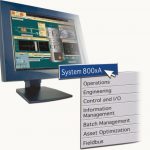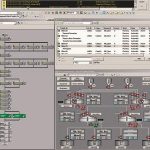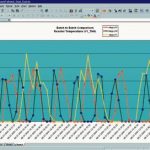Users especially from the chemical and pharmaceutical industries force automation suppliers to deliver added value in the form of comprehensive production management. In addition to standard control equipment, they seek methods and tools that focus on process optimisation while ensuring validated automated solutions. The equipment must be flexible and fast – a vital prerequisite of successful operations in a rapidly changing market.
Martina Walzer
It is also crucial to allow production at the optimum value and derive maximum benefit from investments, in order to ensure the best possible return on investment (ROI). Integrated and consolidated information handling, as realised in ABB’s Industrial IT Extended Automation System 800xA, is the key to this approach.
800xA extends the scope of traditional control systems to include all automation functions in a single operating and engineering environment, so that plants or mills can run more efficiently and intelligently despite substantially lower costs. Thanks to the standardised communication interfaces and their intensive use throughout the whole system, the controller hardware itself no longer plays the leading role in the automation arena. Genuine added value is achieved by processing and advanced handling of data. 800xA collects and processes data from various sources and consolidates valuable information.
Core functional areas
Industrial IT System 800xA extends far beyond the reach of traditional automation systems to achieve the productivity gains necessary to succeed in today’s business markets. This reach embraces not only essential process control but also production management, safety systems, smart instrumentation, smart drives and motor control, robotics, information management, asset optimisation and documentation. Its unique environment manages one set of consistent data for single-point entry, single-point change and re-use across the plant.
The growing deployment of peripheral applications related to productivity improvement vastly increases the amount of data available within the plant, utility or mill. Yet without the proper context, plant personnel can be exposed to information overload. With system 800xA’s single user interface, management, operations, maintenance and engineering personnel directly access the specific information and functions that are relevant to them. This eliminates wasted time spent searching through data or views that are not really dedicated to the individual job function in order to get to the desired information. Users log into the system using their specific user name and password and see the information presented in their own personalised environment.
Added value throughout the process
Behind any drug are a complex manufacturing process and a lot of regulations – from the delivery of the raw materials to assembling, palletising and distributing the pharmaceuticals. 800xA’s basic architecture ensures information consistency from the outset, including the very first information from the receiving control and laboratory information management systems (LIMS).
In case of batch production, the 800xA batch management module delivers the tools needed to achieve compliance with FDA 21 CFR Part 11, cGMP requirements and GAMP guidelines. Facilitating the validation of the process automation system, 800xA eliminates the need for maintaining paper records as well as other cumbersome, work-intensive procedures. In addition, its strict access controls meet regulatory and validation requirements, resulting in quicker, smoother market entry. Security, audit trail, change management, electronic signature, automated reporting and archive and retrieval are integral to all system applications. The seamless integration gives the world access to even the most advanced possibilities opened up by state-of-the-art control technology. There is no need to change the environment in order to navigate, for instance, from standard operator displays to recipe management. Inconsistencies and redundant configurations are a thing of the past.
Online batch modifications
Unique on-line recipe editing provides additional flexibility during batch execution. Without stopping the batch, the user can modify recipe sequences, equipment assignments and recipe parameters, for example in order to save the current batch. Modifications can be performed on-line and there is no need to recompile or download, which would inevitably mean a restart. All modifications to the control recipe are automatically saved in the batch production record.
Operators can navigate from a particular recipe face directly to the control logic responsible for executing it. There is no longer any need to start another configuration tool in another environment or on another PC.
Scheduling control recipes is easy on the basis of master recipes and batch-specific formulation data. The user can select the required equipment either at the scheduled time or dynamically at run-time, which is very useful for maintaining production flexibility in case of a sudden machine shut-down.
The schedule function also supports multiple batch executions within a campaign.
This adds a completely new dimension to flexible exception handling dedicated to production needs. 800xA implements exception procedures extending far beyond the procedure model of S88. They provide the ability to configure exception handling logic on the basis of actual process parameters within the recipe, greatly simplifying the task of logic definition for handling production-specific abnormal conditions. The PDL (production data log) functionality for information management logs all events consistently and automatically.
Flexible alarm handling
PDL archives production information according to the recipe structure. This basic information makes it easy to analyse the key performance indicators (KPIs) of single batches in order, for example, to identify the optimum parameter settings. Comprehensive logging functions using predefined or user-defined templates fulfil regulatory requirements.
Since the very beginnings of plant automation, notifying plant personal has always been an essential core functionality of any control system. Today, people are often no longer present in the control room itself, but simply assigned to the equipment. There is consequently a need for advanced methods of sending alarm information to the right people at the right time, regardless of their physical location. In the end, the plant has to be operated economically and efficiently – and therefore cost-optimally.
800xA uses mobile services to transfer messages to mobile equipment like pagers or mobile phones with text message technology. Email is of major importance in this connection, because context-specific additional information may provide an initial indication of how to solve the problem and direct maintenance personal to the appropriate area. The system allows destination addresses to be configured, in which case a scheduler determines who is the right person to inform, that is to say who is currently in charge of service issues. A timer checks whether this error is acknowledged within a defined time interval. If there is no answer, the message is sent again – either to the same destination or to the next recipient, depending on the system configuration.
Performance continuously monitored
Feedback in real time on actual production figures is of major importance for performance monitoring in a plant or production line. These figures help derive corrective action which can improve overall equipment effectiveness (OEE) within a short time. The same figures make it simpler to understand the potential of the existing automation equipment. Production costs for time, money and equipment are reduced, ensuring a faster return on investment (ROI).
The Real Time Production Intelligence (Real-TPI) software package uses an OEE analysis to determine the production data that is required for a loss calculation. Bottlenecks can be identified and eliminated, traditional – in other words, cyclic – maintenance procedures can be replaced by predictive ones based on process analysis and KPIs can be determined easily. There are numerous long-term advantages spanning every aspect of operation.
cpp 438
Share:









